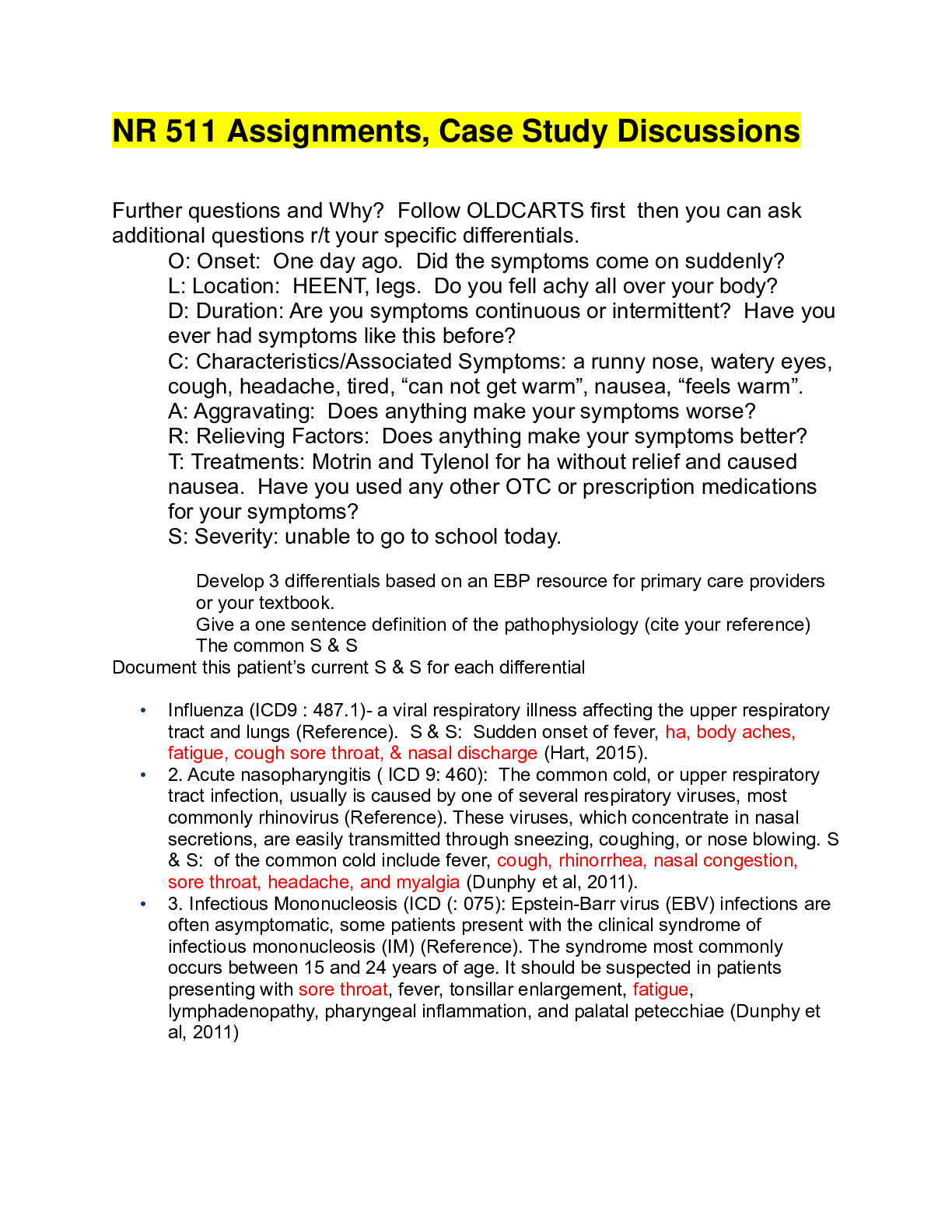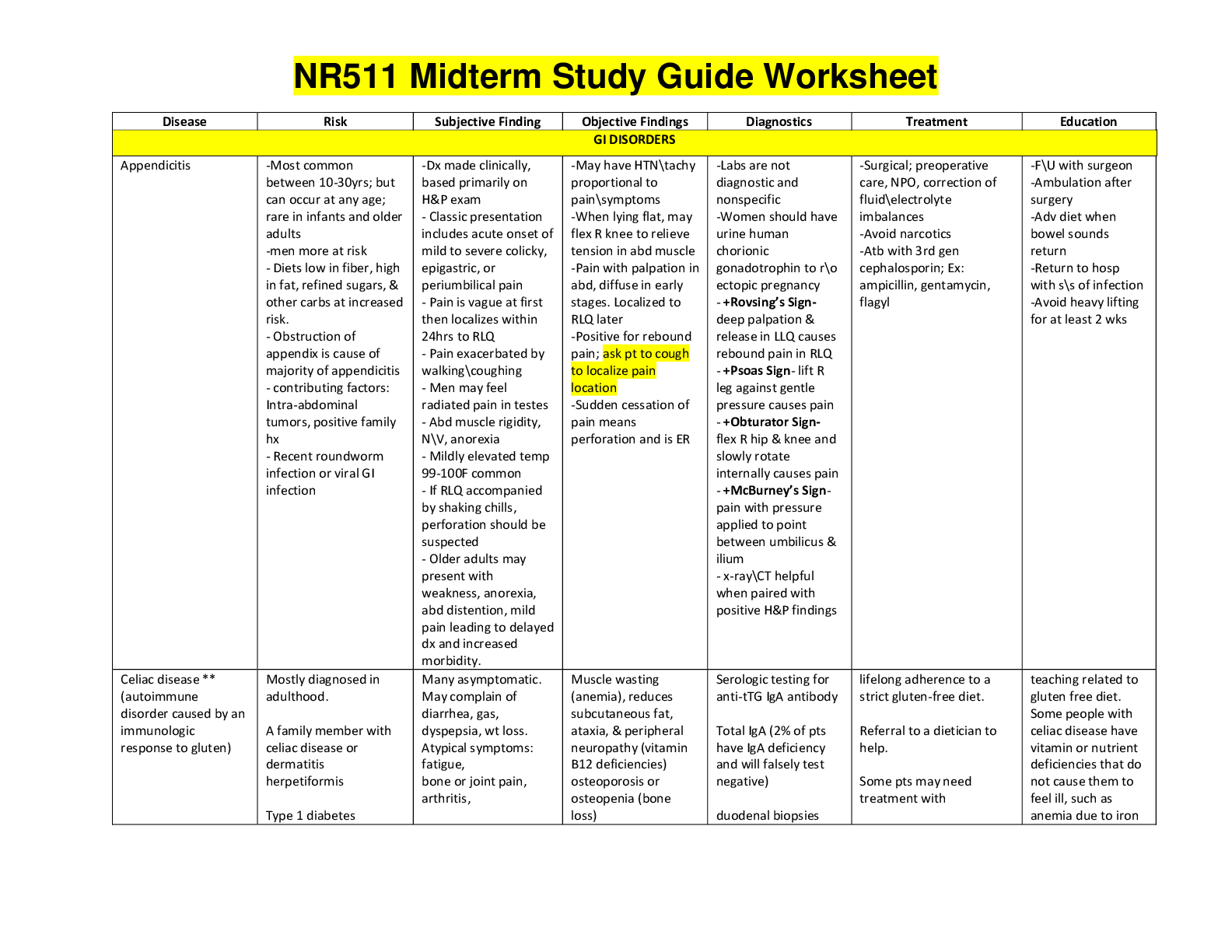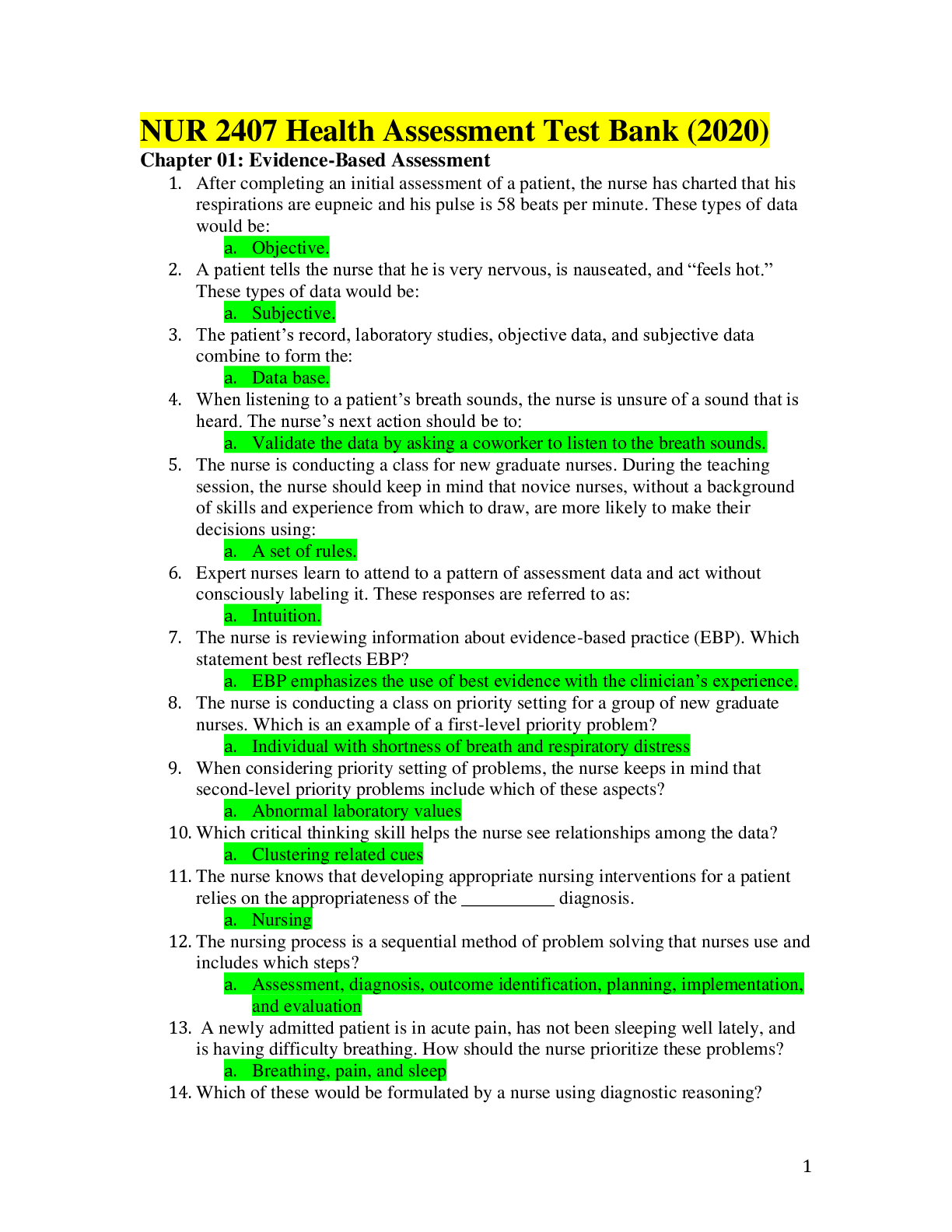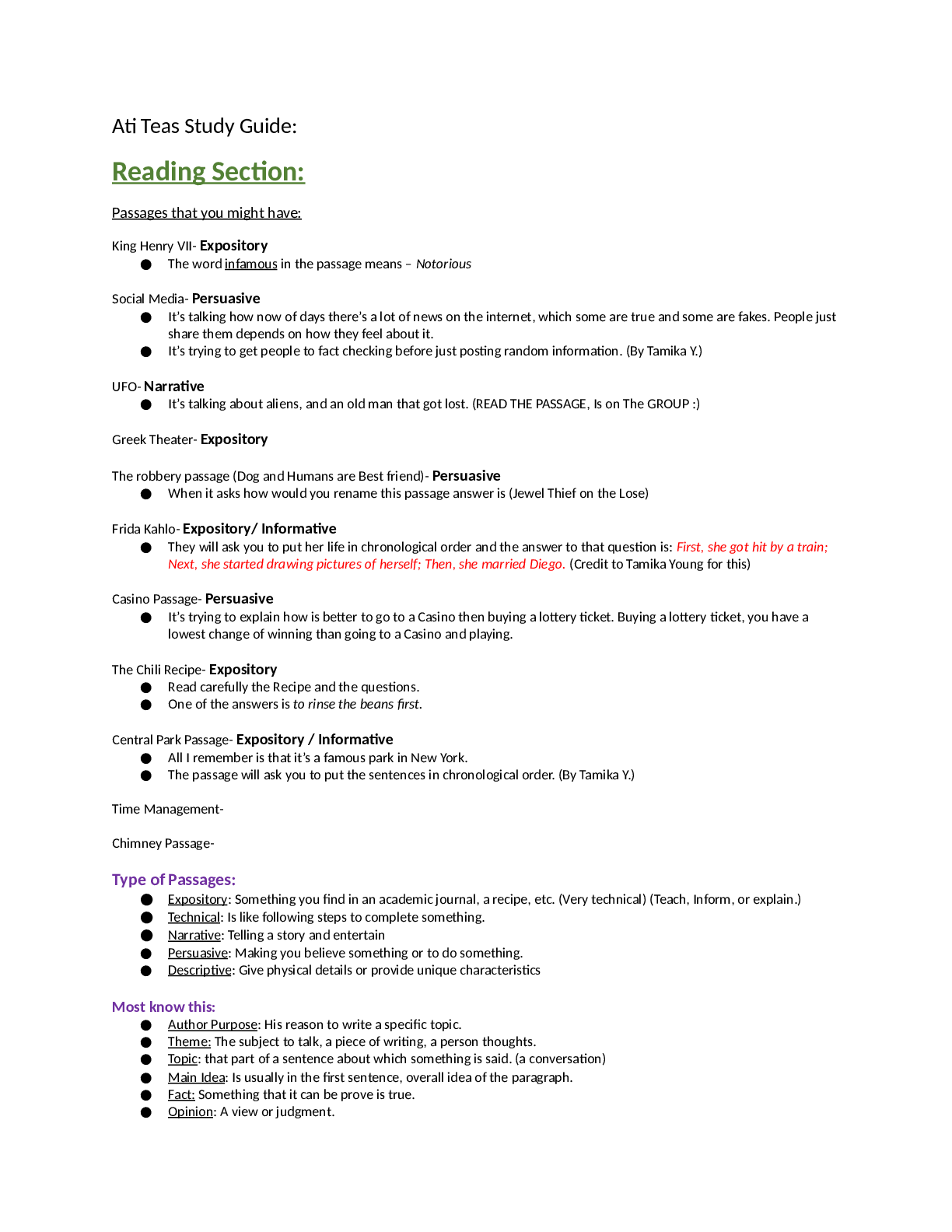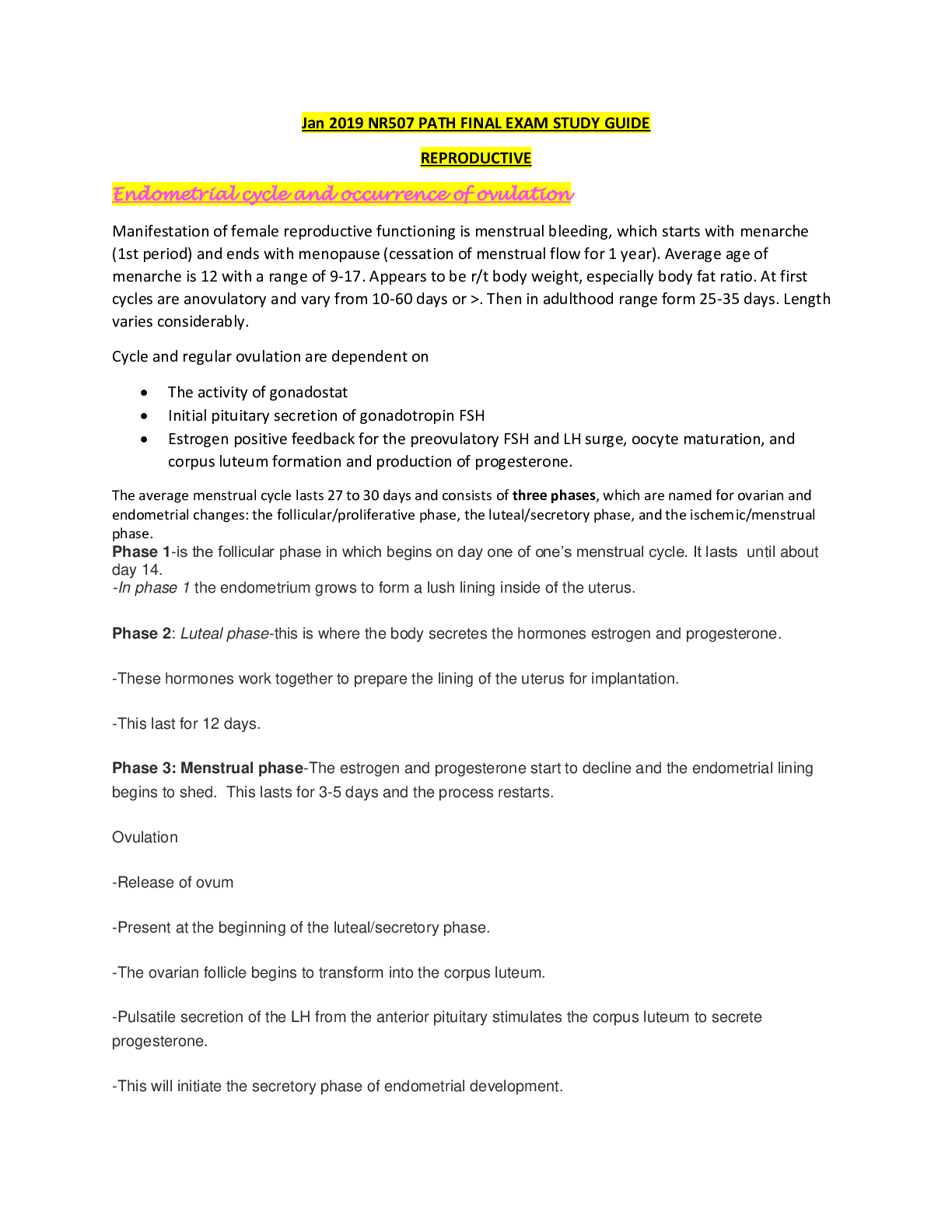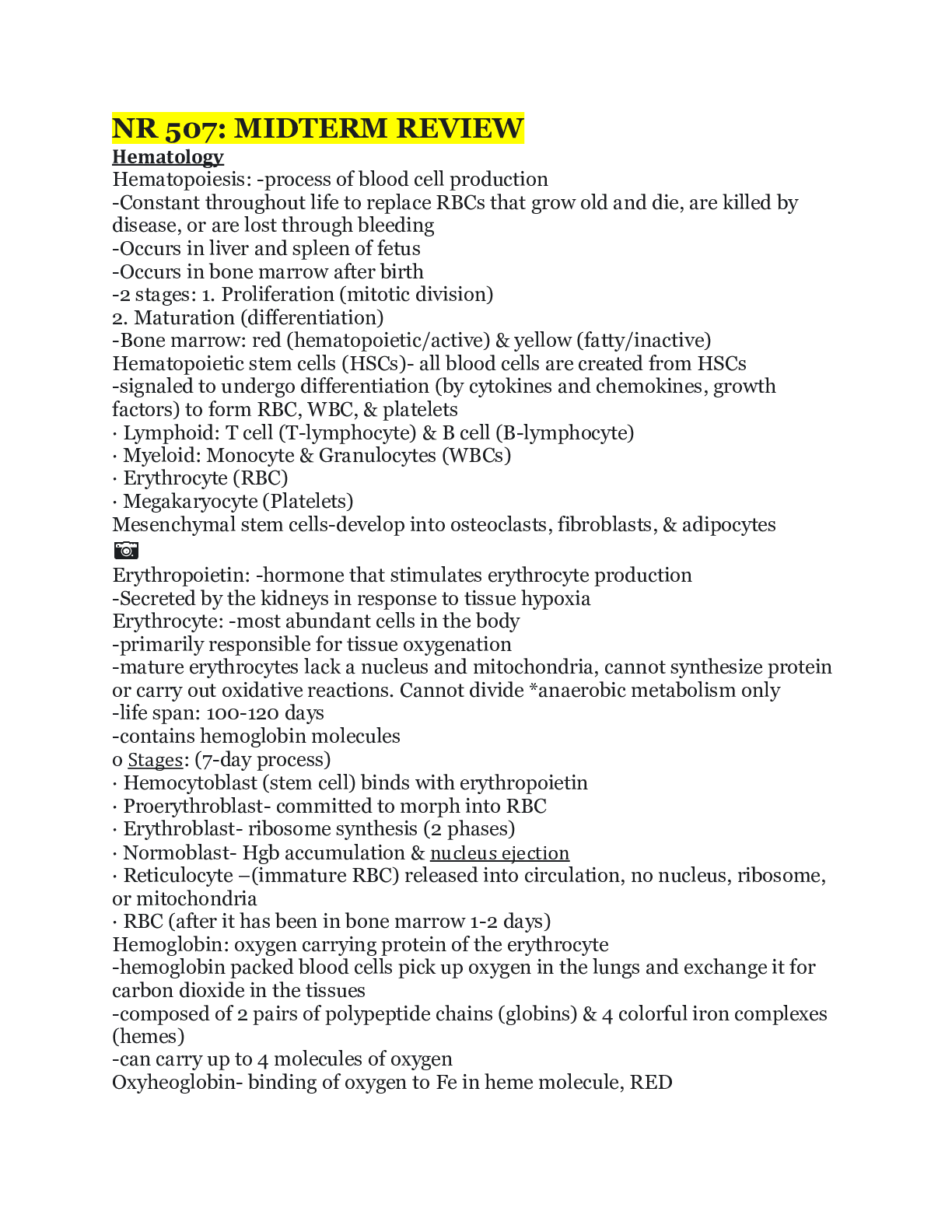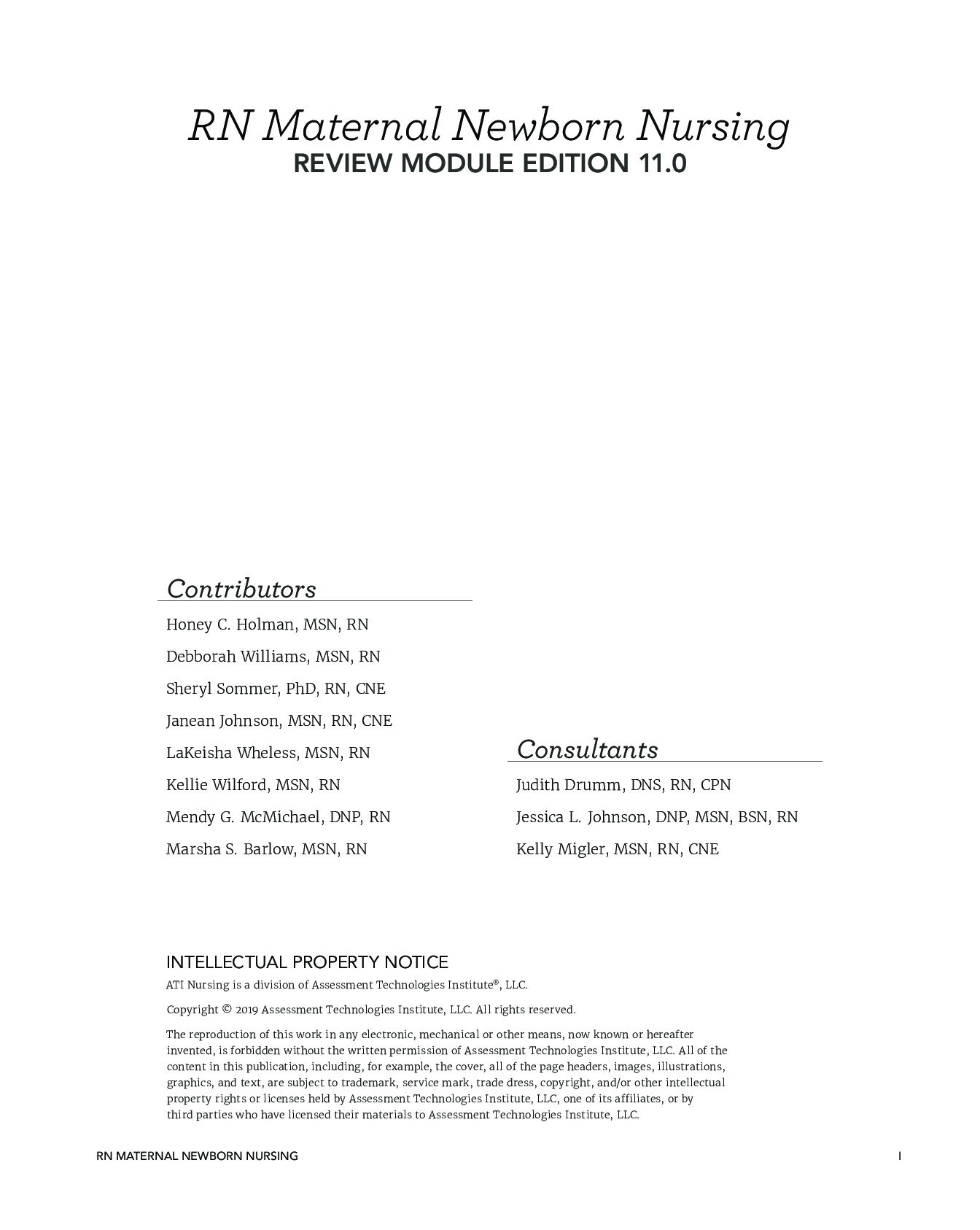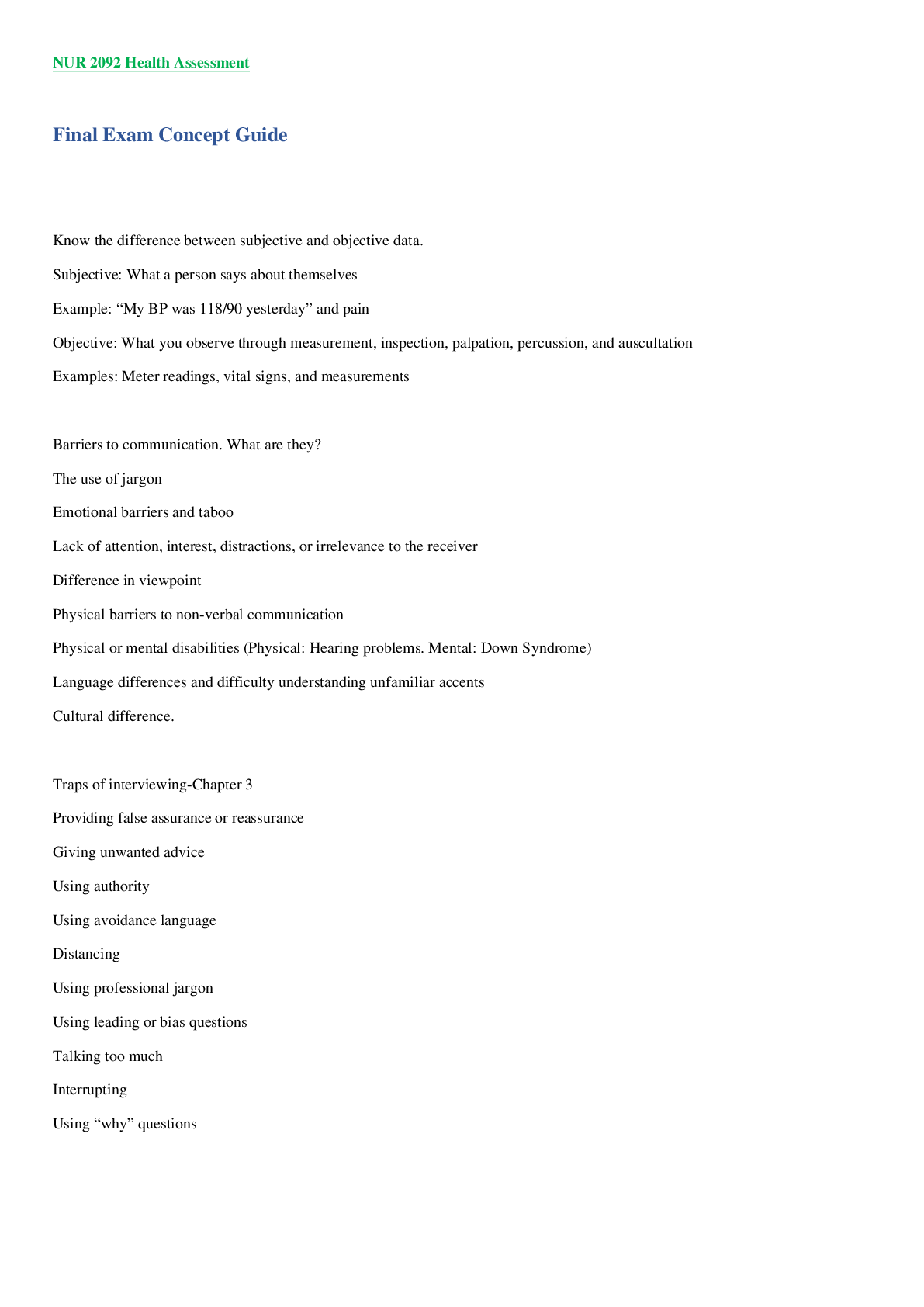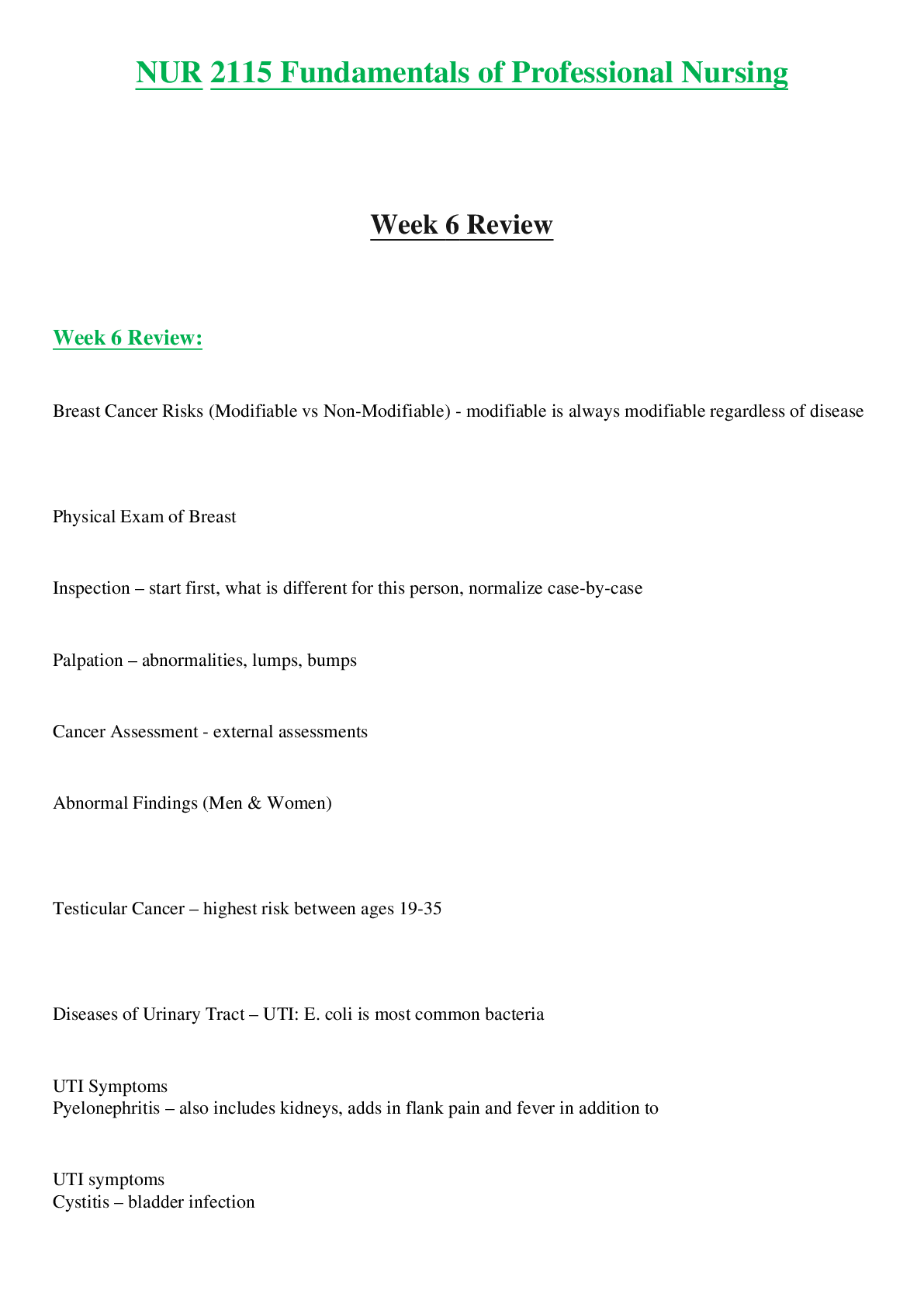Environmental Science > STUDY GUIDE > ENV 101 Introduction to Environmental Science Study Guide for Exam 3: Chapters 7, 8, 9, 10 (All)
ENV 101 Introduction to Environmental Science Study Guide for Exam 3: Chapters 7, 8, 9, 10
Document Content and Description Below
ENV 101 Introduction to Environmental Science Study Guide for Exam 3: Chapters 7, 8, 9, 10 Chapter 07 Human Populations 1. Historically, up until the middle ages, populations were mostly limit ... ed by A. Low fertility rates B. Culturally imposed family planning practices C. Disease, famine and war D. Religious restrictions on marriage E. Infanticide 2. ____________ are the most numerous vertebrate organisms on Earth. A. Fish B. Insects C. Rodents D. Birds E. Humans 3. Human population growth most closely resembles A. Carrying capacity geometric increase B. Irruptive growth C. Malthusian growth D. S-shaped growth curve E. J-shaped growth curve 4. The world human population reached 1 billion in about _________ and passed ____________ in 1999. A. 1400; 78 billion B. 1500; 6 trillion C. 1600; 78 million D. 1700; 6 million E. 1800; 6 billion 5. The population theory held by Thomas Malthus was that the human population would A. Never reach its environment's carrying capacity B. Develop a modern utopia C. Reach its environment's carrying capacity and then maintain equilibrium D. Maintain equilibrium with its carrying capacity E. Outstrip its resources, then suffer starvation and misery 6. Neo-Malthusians argue that A. Malthus's eighteenth century theories apply to similar circumstances today B. We should never return to the conditions observed by Malthus in his day C. Malthus could be useful today if reinterpreted D. Malthus was wrong from the start E. None of these represent the viewpoint of Neo-Malthusians 7. Technological optimists argue that technological advances have A. Led to the increase in human population but whether we can continue is of great concern B. Proved Marx wrong in his predictions of famine and disaster C. Proved Malthus wrong in his predictions of famine and disaster D. Been developed because there are more people, supporting the view that more people are the "ultimate resource." E. Been a neutral factor in the issue of population growth 8. Malthus and Marx A. Worked together to form their theories B. Agreed about the root causes of overpopulation, poverty and social upheaval C. Disagreed about the root causes of overpopulation, poverty and social upheaval D. Held the same beliefs but worked on different issues E. Disagreed about the severity of overpopulation, poverty and social upheaval 9. Human ingenuity and intelligence as the "ultimate resource" is the central theme in the argument of A. Julian Simon B. John Muir C. Thomas Malthus D. Neo-Malthusians E. Marxism 10. Demography is the science that describes A. The earth's carrying capacity B. Population changes and characteristics C. Energy resources D. Food production E. Environmental factors that affects population sizes 11. Ninety percent of the world's population growth in the next century is expected to occur in A. Less-developed countries B. China C. Developed countries D. Moderately developed nations E. India 12. Why is Russia's population declining? A. There is a one-child policy similar to the one in China and Thailand B. There has been a massive education campaign to reduce births C. The standard of living has decreased leading to lower infant mortality and lower birth rates D. Russia's population is not declining E. The standard of living has decreased leading to higher death rates and lower birth rates 13. The I = PAT formula says that our environmental impacts (I) are the product of A. The population size times affluence and the amount of time it took for the population to reach B. its current size C. The population size times affluence and the technology used to produce goods and services consumed D. The population size times the amount of technology used E. The percentage of affluence times the percentage of technology produced F. None of the above is correct 14. Crude birth rates are measured in terms of the number of children born A. In a single year B. Per family C. Per family per year D. Per 1000 people each year E. Per 1000 people in the general population 15. The total fertility rate is the number of children born A. To the average woman per year B. To the average woman during her lifetime C. In the world during a single year D. In a population during a single year E. In a population during an entire generation 16. There is some evidence that population growth today is ____________ rather than ______________. A. Slowing slightly; continuing to accelerate B. Continuing to accelerate; slowing slightly C. Increasing; leveling off D. Leveling off; decreasing E. Leveling off; slowing slightly 17. The main cause of world population growth in the past 300 years has been A. Increasing fecundity B. Rising fertility C. Higher birthrates in developing countries D. Increasing immigration E. Falling mortality 18. The difference between "total growth rate" and "natural increase" is that total growth rates A. Include only the number of births and deaths B. Include immigration and emigration as well as births and deaths C. Include only immigration and emigration D. Include infant mortality as well as adult deaths E. Are not expressed as percentages 19. The average age that a newborn can expect to attain in a given society is referred to as A. Life expectancy B. Infant mortality C. Life span D. Survivorship E. Life age 20. The population represented by the age class histogram on the right will A. Have a large population of old people soon B. Not grow much in the coming years C. Soon begin to decline D. Grow substantially in the future E. Grow slowly in the future 21. The age class histogram on the right could represent the population of A. The United States B. Western Europe C. Uganda D. Japan E. Sweden 22. The age class histogram on the left could represent the population of A. Singapore B. Mexico C. Uganda D. India E. Sweden 23. A pyramid-shaped age structure histogram is characteristic of a(n) _________ population. A. Stable B. Expanding C. Declining D. Unpredictable E. Diminishing 24. A dependency ratio is a comparison between the numbers of A. Working and nonworking people B. Parents and children C. Old people and young people D. Young infants and older adults E. Middle aged people and infants 25. Pronatalist pressures are influences that lead people to A. Increase fecundity B. Have more children C. Have fewer children D. Prevent infant mortality E. Wait until later in life to have children 26. Women who ________ are least likely to have many children. A. Cannot afford children B. Live where many children die young C. Are subordinate to their husbands D. Are able to earn an income for themselves E. All of these are correct 27. The demographic transition refers to a country's change from A. High birth and death rates to low birth and death rates B. High to low birth rates and low to high death rates C. Low to high birth rates and high to low death rates D. A majority of young people to a majority of elderly people E. A majority of elderly people to a majority of young people Use the following demographic data on three hypothetical countries. 28. The most industrialized country listed is A. Country "A" B. Country "B" C. Country "C" D. None of the countries listed are likely to be industrialized E. It is impossible to use the data in the table to identify an industrialized country 29. The message from author Garret Hardin's "lifeboat ethics" is that A. Helping poor people will, in time, reduce their rate of reproduction B. The poorer countries of the world are caught in a demographic trap C. Economic growth will reduce the birth rate of poor nations D. The world has enough resources for everybody E. Helping poor people will simply increase their rate of reproduction 30. Proponents of social justice believe that environmental and social problems will decrease if A. We can educate poor people about family planning B. Resources are distributed fairly C. Better ethics are taught to poor, uneducated populations D. We just reduce the number of people on Earth E. We concentrate on population control 31. One of the _________ effective ways to stabilize populations is to _________. A. Most; provide free contraceptives B. Least; provide free contraceptives C. Least; decrease child mortality D. Most; decrease child mortality E. Most; expect mandatory sterilization 32. Less developed countries can best argue that developed countries are primarily responsible for overpopulation problems because A. Developed countries grow most of the global food resources B. Less developed countries have no population-based environmental problems C. Less developed countries have recently drastically reduced their fertility rates D. Developed countries do not understand a global society E. Less developed countries were many times impoverished by colonialism 33. Family planning means enabling people to A. Have fewer children so that the population growth rate can reach ZPG B. Have no children C. Have many children D. Decide in advance how many children they should have E. Have more children if they live in a country with a birth dearth 34. The most pessimistic projection of population growth projects the human population to reach 25 billion by 2150. True False Chapter 08 Environmental Health and Toxicology 35. The World Health Organization regards health as primarily a matter of ________ well being. A. Physical B. Mental and physical C. Social and mental D. Physical, mental and social E. Physical and social 36. Historically, the greatest threats to human health came from A. Carcinogenic or toxic chemicals B. Psychological stress factors due to crowding C. Pathogenic organisms D. Teratogenic chemicals E. Injuries (intentional and unintentional) 37. _______________, rather than ______________ are becoming the leading causes of disability and premature death worldwide. A. Chronic conditions such as cardiovascular disease; infectious diseases such as malaria B. Infectious diseases such as malaria; chronic conditions such as cardiovascular disease C. Traffic deaths; infectious diseases such as malaria D. Chronic conditions such as cardiovascular disease; traffic deaths E. Infectious diseases such as malaria; traffic deaths 38. Infectious diseases such as diarrhea are closely linked to A. Emotional stress B. Malnutrition C. Toxicity effects D. The over consumption of fats E. All of these exacerbate infectious diseases such as diarrhea 39. Hazardous substances ______________ while toxins are ______________. A. React with specific cell components to kill cells; poisonous substances B. Are dangerous substances; poisonous substances C. Are usually of concern at all concentrations; dangerous substances D. Are poisonous substances; also poisonous substances E. None of the above is correct 40. Toxic substances are dangerous because they A. React or interfere with specific cell functions B. Can physically remove or tear tissues C. Are usually synthetic D. Cause debilitating, parasitic diseases E. Cause excessive water accumulation in tissues 41. Which of the following practices contributes the least to antibiotic or pesticide resistance? A. Domestic farm animals are fed low doses of antibiotics to increase weight gain B. A person takes the full course of the appropriate antibiotic when she has a viral infection C. A person takes the full course of the appropriate antibiotic when she has a bacterial infection D. A person takes an anti-malarial drug when he does not have malaria E. Mosquito populations in the tropics have been sprayed with DDT for about 50 years 42. Among the most important characteristics of chemicals in determining their environmental risks is/are A. Solubility B. Reactivity C. Persistence D. Toxicity E. All of these 43. The biomagnification of DDT demonstrates that A. Higher trophic level organisms can concentrate toxins in a type of "inverse biological pyramid." B. Birds should not depend on fish for food C. DDT is easily metabolized and excreted by most organisms D. DDT is an extremely water-soluble material E. Water-soluble toxins are widespread 44. Most people do their own personal risk assessments based upon A. Scientific data B. Whimsical preference devoid of logic C. Logical reasoning about relative risks D. Personal biases and preferences as well as logic E. Statistical probabilities Chapter 09 Food and Agriculture 45. Undernourished parents often raise children who are undernourished because the parents A. Transfer genetic deficiencies to their children B. Do not know any better C. Cannot afford to feed their children properly D. Do not have access to the information about nutrition E. All of these are reasons for the vicious cycle 46. Food security has to do with A. A country's dependence on cash crop exports B. Preventing wars over diminishing food supplies C. The ability of a population to obtain food on a day-to-day basis D. The total volume of food a country imports E. The total volume of aid a country receives 47. People can suffer malnourishment if they consume large amounts of ______ instead of _______. A. Fat and sugar; vitamins and protein B. Proteins; carbohydrates C. Vitamins; protein D. Proteins and minerals; vitamins E. Fiber; processed foods 48. People who subsist on starchy foods such as cassava, potatoes and white rice A. Often receive insufficient protein B. Are usually severely overweight C. Have the healthiest possible diet D. Are sure to meet all their nutritional needs E. Are usually suffering from goiter 49. The three crops that humans rely on for the majority of nutrients and calories are A. Potatoes, wheat and oats B. Wheat, rice and maize (corn) C. Barley, oats and rye D. Maize (corn), oats and rice E. Oats, beans and barley 50. Most humans rely on just a few of the world's animal and plant species for food because only a few A. Are edible B. Are available C. Have been discovered D. Food types are what we are accustomed to eating E. All of these are true 51. Which of the following does not describe the status of the world's wild fisheries? A. Overharvesting threatens the fisheries B. Subsidies are necessary to make the fisheries profitable C. Fish farming has allowed wild fish to recover worldwide D. Habitat destruction threatens the fisheries E. All of these describe the status of wild fisheries 52. Which of the following is the most correct definition of soil? A. A complex of minerals that provide energy for plant growth B. A complex mixture of organic matter, minerals and living organisms C. A mass of dead organic matter and detritus; dirt D. An elaborate mixture of organic matter and minerals E. All of these adequately describe soil 53. The critical organic component of soil that gives it its structure is termed A. Clay B. Humus C. Parent material D. Heavy soil E. Bedrock 54. Topsoil contains predominantly A. Organic material B. Mineral material C. Plant roots D. Insoluble minerals and sand E. Mixed organic material and mineral particles 55. In developed countries, the most recent increases in agricultural productivity have come from A. Irrigation in arid areas B. Increased fertilization C. New crop varieties D. An increase in the land being used for agriculture E. Irrigation, increased fertilization and new crop varieties 56. About what portion of world freshwater withdrawals is used for agriculture? A. 1/10 B. 2/3 C. 3/4 D. 9/10 E. 1/2 57. Which is the best cropping method for reducing erosion? A. Rotating corn, wheat and clover B. Growing corn continuously C. Growing wheat continuously D. Growing clover continuously E. None of these is more effective in reducing erosion 58. Which of the following uses the least amount of energy in industrialized farming practices? A. Fuel for tractors and other machines B. Production of chemical fertilizers C. Use of pesticides D. Drying the crops E. Transporting the crops to market 59. "Green manure" is A. Fresh animal waste that has not aged B. Green plants, especially legumes that are planted and then plowed under C. Green plants, especially grasses that are raised for animal fodder D. Commercial fertilizer that is certified organic E. Fresh animal waste that is certified organic 60. Worldwide, traditional and native varieties of food crops have __________ since the introduction of green revolution varieties. A. Become more widespread B. Stayed about the same in terms of use C. Been slightly influenced by new varieties D. Been widely replaced by new varieties E. Spread from region to region, leading to increased diversity 61. Fifty years ago, there were several hundred varieties of wheat grown in the Middle East. Now a few of the more modern high responder varieties have replaced the indigenous species. What are the implications of this change? A. The productivity of wheat should continue to rise and increase the availability of food per person B. Genetic resources are diminished and an epidemic of wheat disease is highly likely due to the reliance on few species C. The high responder varieties will need specialized harvesting methods because they are so productive D. The biodiversity of wheat species has increased because of the introduction of few hybrid species E. All of these are correct 62. The first genetically modified animal for human consumption is a salmon with extra growth hormones. Which of the following is not a concern about this animal? A. They will probably outcompete wild salmon for mates B. Eating this fish will add extra hormones into our diet C. They will probably outcompete wild salmon for food D. They will probably outcompete wild salmon for habitat E. These are all worries about the GM salmon 63. Which of the following is the best way to ensure soil health? A. Maintaining clean, open ground between rows B. Strip farming and leaving residues on fields after harvest C. Clearing fields immediately after harvesting D. Establishing ridges running up and down hills E. All of these are good practices in ensuring soil health 64. The benefits of leaving crop residues on a field after harvest include A. Protecting soil organisms B. Reducing evaporation C. Breaking the erosive effects of wind and water D. Reducing soil temperatures E. All of these are correct 65. One of the ecological benefits associated with aquaculture is the organic material generated from the aquaculture tanks. The nutrients increase the health and productivity of the surrounding natural ecosystem. True False 66. Agricultural cropland is shrinking worldwide. True False 67. Buying shade grown coffee and cocoa has a minimal effect on local ecosystems where they are grown. True False 68. Terracing is more sustainable than conventional farming, but is also more expensive. True False 69. Agricultural (farm) subsidies are especially effective in helping preserve small "family farms." True False Chapter 10 Pest Control 70. Pest organisms tend to be A. Specialist species B. Generalist species C. Migratory species D. Endemic species E. Consumers 71. Of the millions of living species, about ____ cause 90 percent of the worldwide crop damage. A. 100 B. 1000 C. 10 D. 500 E. 50 72. Which of the following usually has the most intensive use of pesticides? A. A soybean field B. A golf course C. An average U.S. kitchen D. A corn field E. All of these are comparable 73. Significant agricultural monetary losses are due to the destruction of _____ through pesticide spray drift and residues on flowers. A. Ladybird beetles B. Honeybees C. Praying mantises D. Monarch butterflies E. Bacillus thuringiensis 74. Most of the pesticides applied in the United States are used in A. Landscaping for private homes B. Agriculture C. Controlling pests in private homes D. Landscaping for both private homes and businesses E. Controlling pests in businesses (e.g., restaurants) 75. Natural organic pesticides are not A. Extracted from plants B. Toxic to humans C. Safe for all animals D. Stable in their natural form E. All of these are characteristics of natural organic pesticides 76. In terms of agriculture, pesticides have lead to _____ for consumers. A. Lower monetary costs B. More attractive produce C. Better produce quality D. More availability of produce E. All of these are correct 77. Approximately ______ percent of the pesticides we use never reach the intended target. A. 15 B. 20 C. 75 D. 50 E. 90 78. Why are pest predator populations so adversely affected by broad-spectrum pesticides? A. In general, predators are more susceptible to the pesticides B. There is less food for the predators when the pest species is destroyed C. Predators in higher trophic levels are more likely to be wiped out than lower trophic levels D. Broad-spectrum pesticides leave more residues than other pesticides and these kill the predators E. Predator populations are not more likely to be adversely affected 79. What is one method that Cubans use on a large scale to fertilize their soil? A. They compost kitchen scraps B. They use imported synthetic organic fertilizers C. They use synthetic organic fertilizers produced in Cuba D. They import organic fertilizers E. They use humus from earthworm farms 80. According to your instructor, what are the two types of “overpopulation” which environmental science must contend with? A. abiotic and biotic B. people and consumption C. pronatalist and postnatilist D. Malthusian and Marxist ENV 101 Chapters 7, 8, 9, 10 Key Terms and Concepts Malthus—population – population growth is checked by famine, disease, and cultural factors. Causes environmental degration Marx—population – human population growth results from poverty and resource depletion I = PAT – environmental impact = population size, affluence, technology two kinds of overpopulation – people and consumption demography – statistics about people, such as births, deaths, where they live, and total population size world population largest populated countries – asia, aftica, and latin America. crude birth rate – number of births in a year per thousand persons crude death rate – number of deaths per thousand persons in any given year total fertility rate – number of children born to an average woman in a population during her entire reproductive life zero population growth – when births plus immigration in a population just equal deaths plus emigration natural increase – crude death rate subtracted from crude birth rate total growth rate – death rate and emigration subtracted from birth rate and immigration life expectancy – the average age that a newborn can expect to attain in a given society population histograms – represent the percentage of the country’s population in consecutive age classes dependency ratio – the number of nonworking compared to working individuals in a population pronatalist pressures – factors that increase people’s desires to have babies birth dearth – low birth rates persist or are not balanced by immigration demographic transition – pattern from high birth and death rates to lower birth and death rates due to improved living conditions usually accompanying economic development demographic transition stages 1. Premodern society food shortages, malnutrition, lack of sanitation and medicine, accidents high death, high birth 2. Death rates fall rapidly. 3. Industrial economy. Birth rates fall 4. Developed country, birth rates and death rates low population predictions: optimistic – social reform, technology, historic pattern, modern communication pessimistic – demographic trap; resource shortages, envir deterioration, economic decline, and political instability social justice – a fair share of social benefits for everyone birth control – any method used to reduce births, including abstinence, delayed marriage, contraception, methods that prevent implantation of embryos and induced abortions family planning – couples determine the number and spacing of their children health – a state of complete physical, mental, and social well-being disease – an abnormal change in the body’s condition that impairs important physical or psychological functions morbidity - illness mortality - death environmental health – external factors that cause disease, including elements of the natural, social, cultural, and technological worlds global disease burden – communicable diseases are being replaced with chronic disorders related to lifestyle, age, ad affluence DALYs – disability-adjusted life years. A measure of disease burden. Combine premature deaths and loss of a healthy life resulting from illness or disability infectors diseases emergent diseases – those not previously known or that have been absent for at least 20 years pathogens ecological diseases – domestic andimals and wildlife that also experience sudden and widespread epidemics conservation medicine – attempts to understand how our environmental changes threaten our own health as well as that of the natural communities on which we depend for ecological services biomagnification – occurs when the toxic burden of a large number of organisms at a lower trophic level is accumulated and concentrated by a predator in a higher trophic level POPs – persistent organic pollutants; have become extremely widespread. Do not break down Synergism – an interaction in which one substance exacerbates the effects of another Risk – the possibility of suffering harm or loss risk assessment – the scientific process of estimating the threat that particular hazards pose to human health chronically undernourished – getting less than the minimum 2,200 kcal per day food security – the ability to obtain sufficient food on a day-to-day basis famine – characterized by large scale food shortages, massive starvation, social disruption, and economic chaos acute food shortages - malnourishment – nutritional imbalance caused by a lack of specific dietary components or an inability to absorb or utilize essential nutrients key food sources – wheat, rice, maize CAFOs – confined animal feeding operation; animals are housed and fed – mainly on soy and corn – for rapid growth Aquaculture – growing aquatic species in net pens or tanks farm policy – subsidies allow farmers to sell their products below the actual cost of production; tries to reduce soil erosion and overproduction of crops soil – a complex mixture of weathered minerals, partially decomposed organic materials, and a host of living organisms humus – residue of decomposed plant and animal material. Gives soil the spongy texture that holds water and nutrients soil horizons – soils are stratified into horizontal layers soil profile – horizons taken together topsoil – surface soil; mineral particles mixed with organic material arable land – unevenly distributed land degradation – based on both biological productivity and expectations of what land should be like soil erosion – a natural process resulting in redistribution of the products of geologic weathering, and is part of both soil formation and soil loss desertification – conversion of productive land to desert agricultural resources – water, fertilizer farming—energy inputs – most food require more energy to produce, process, and transport than we get from eating them genetic engineering – removes DNA from one organism and splices it into the chromosomes of another. green revolution – dwarf, high yielding wheat and rice grown around the world; improvements in farm production from technological advances and modification of a few well-known species GMOs – new traits. Pest-resistance, protein and vitamin, vaccines. Might produce superweeds, native biodiversity reduced, toxins sustainable agriculture – attempts to produce food and fiber on a sustainable basis and repair the damage caused by destructive practices soil conservation – contour plowing, strip farming, terracing, perennial species cover crops locavore biological pests pesticides inorganic pesticides natural organic pesticides chlorinated hydrocarbons pesticide benefits pesticide problems pest resurgence pesticide treadmill pesticide alternatives alternative pest control strategies [Show More]
Last updated: 3 years ago
Preview 1 out of 14 pages
.png)
Buy this document to get the full access instantly
Instant Download Access after purchase
Buy NowInstant download
We Accept:

Reviews( 0 )
$15.00
Can't find what you want? Try our AI powered Search
Document information
Connected school, study & course
About the document
Uploaded On
Aug 12, 2020
Number of pages
14
Written in
All
Additional information
This document has been written for:
Uploaded
Aug 12, 2020
Downloads
0
Views
186

